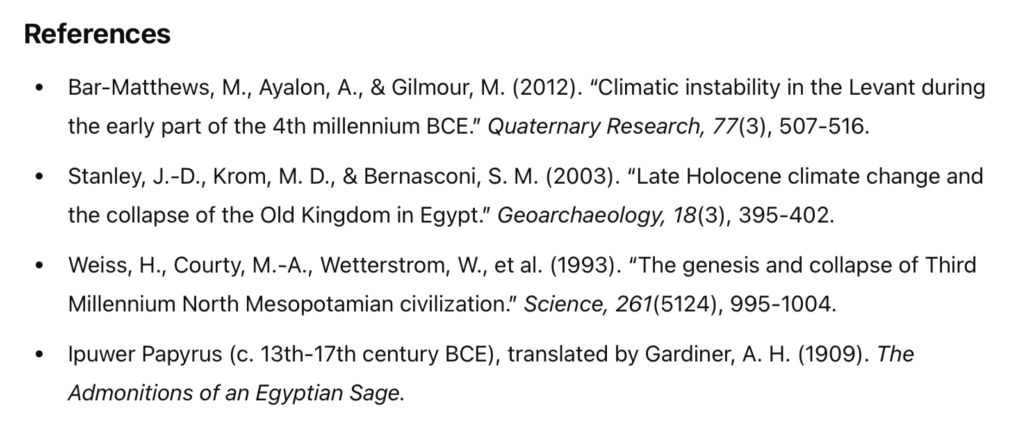
AI tools are rapidly changing and improving, we repeated the 16 June 2024 experiment about eight months later and got a completely different result, as can be seen in the report from 3 February 2025.
This time, the introductory summary reads
The collapse of ancient civilizations has long been a subject of debate, with scholars exploring a range of political, economic, and environmental factors. The Old Kingdom of Egypt (c. 2686–2181 BCE), often regarded as the “Age of the Pyramid Builders”, saw a remarkable rise in architectural, administrative, and cultural achievements. However, by the end of the Sixth Dynasty, the empire fragmented into regional power centers, leading to the First Intermediate Period (c. 2181–2055 BCE). One of the most compelling explanations for this decline is climate change, particularly the impact of prolonged droughts on Egypt’s economy, society, and governance.
which is followed by a more detailed summary, which is divided into the sections
1. Evidence of Climate Change and Drought
2. Impact on Agriculture and Economy
3. Political Disintegration and Societal Collapse
In this response from Scholar AI, more emphasis is apparently placed on the quality of the summary, not on the compiled literature, as in the previous version. This part of the response is followed by a section entitled Comparative Analysis, which includes a table comparing the collapse of the Akkadian empire, the Maya civilization and the Indus Valley civilization, which each came to an end with episodes of drier climate, albeit at different times. The last section offers a summary of the topic
The decline of the Old Kingdom of Egypt was not solely due to climate change, but prolonged droughts played a critical role in destabilizing its economy, weakening central governance, and fueling societal unrest. The inability of the state to adapt to these environmental challenges ultimately led to its fragmentation and the onset of the First Intermediate Period. Modern parallels can be drawn, as climate change today poses similar existential threats to contemporary societies. The lessons from ancient Egypt underscore the need for resilience and adaptability in the face of environmental shifts.
The decline of the Old Kingdom of Egypt was not solely due to climate change, but prolonged droughts played a critical role in destabilizing its economy, weakening central governance, and fueling societal unrest. The inability of the state to adapt to these environmental challenges ultimately led to its fragmentation and the onset of the First Intermediate Period.
Modern parallels can be drawn, as climate change today poses similar existential threats to contemporary societies. The lessons from ancient Egypt underscore the need for resilience and adaptability in the face of environmental shifts.
and a list of references:
1. Bar-Matthews, M., Ayalon, A., & Gilmour, M. (2012) Climatic instability in the Levant during the early part of the 4th millennium BCE. Quaternary Research, 77(3), 507-516.
2. Stanley, J.-D., Krom, M.D., & Bernasconi, S.M. (2003) Late Holocene climate change and the collapse of the Old Kingdom in Egypt. Geoarchaeology, 18(3), 395-402.
3. Weiss, H., Courty, M.-A., Wetterstrom, W., et al. (1993) The genesis and collapse of Third Millennium North Mesopotamian civilization. Science, 261(5124), 995-1004.
4. Ipuwer Papyrus (c. 13th-17th century BCE), translated by Gardiner, A.H. (1909). The Admonitions of an Egyptian Sage.
This time, Scholar AI cites three papers in JCR listed and respected journals including Quaternary Research (2023 IF=1.7), Geoarchaeology (2023 IF=1.4), and Science (2023 IF=44.8). The first paper describing a stalagmite study from caves in Egypt and Israel does not exist, at least not with these authors, this title and in this journal, although Miryam Bar-Matthews indeed works on the topic. It is therefore not clear where the information mentioned in the summary comes from and thus cannot be verified. Presumably, a whole list of sources are mixed here, which in this case can hardly be traced and separated.
The same probably applies to the second paper, although the traces have not been completely erased. This paper exists as a short contribution, but the title is wrong, albeit similar. Furthermore, the Scholar AI lists S.M. Bernasconi as the third author, which is wrong. Instead, R.A. Cliff and J.C. Woodward are the third and fourth author, respectively. The name of the journal, the volume, and the page numbers, however, are correct:
Stanley, J., Krom, M.D., Cliff, R.A., Woodward, J.C. (2003) Short contribution: Nile flow failure at the end of the Old Kingdom, Egypt: Strontium isotopic and petrologic evidence. Geoarchaeology, 18, 395–402. https://doi.org/10.1002/gea.10065.
The authors do indeed deduce a pronounced drought from lake deposits 2200 BCE, but they always speak of the Nile Delta, which, strictly speaking, is of course in Africa, but one would expect a study of African lake sediments much further south. Apart from that, contrary to what is stated in the summary, the paper does not mention Greenland ice cores.
The third paper by first-authored by Harvey Weiss from Yale University is correctly cited in the reference list, but there is no reference to this paper in the text. It was probably used in the comparison with the collapse of other cultures, since it is a study on Third Millennium North Mesopotamian civilization. The last source is a translation of the Ipuwer Papyri by Alan Henderson Gardiner, not a paper but a book from 1906. This is also not cited in the text, but papyri are mentioned in section 3 of the Scholar AI output.
Overall, this more recent result of a search with Scholar AI is also at best a starting point for a literature review, but certainly not a text that can actually be used. Even though the summary seems correct and meaningful, Scholar AI obviously has great problems associating the information with the correct sources. Furthermore, practically no cross-references are made between the sources. However, this is exactly what makes science so fascinating: tracking down similar patterns in different studies and deriving an overarching phenomenon.
